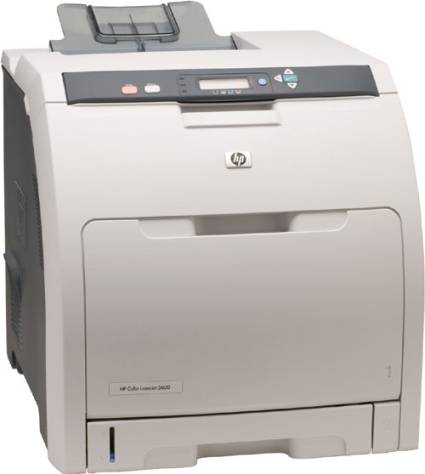Color Laser Printers: Fast and Affordable!
HP Color LaserJet 3600
The Color LaserJet 3600 has just about everything you could want in a modern one-pass color laser printer. It's fast - even though its 17 ppm engine may not be the fastest in terms of nominal speed - its cost per page is fairly good, and it has a few innovative functions that make it a very good choice.
Ergonomics And Functions
The version we tested has no network port, but there is a model with one for about $100 more. Except for that, this printer has everything. It has a relatively small footprint and also, like the 2600n, uses Instant-On Fusing technology, which reduces warm-up time to almost nothing. Its cartridges combine both the toner and the drum, which means that it operates like new when the cartridges are changed. Finally, its ergonomics are perfect, with a restrained but complete control panel.
Printing Speed
For once, the nominal speed of the printing engine almost matched what our tests showed. Printing a fairly heavy word-processing document, we clocked a speed of 15 ppm, whereas the manufacturer claims 17 ppm. Instant-On Fusing also significantly reduces the time for printing the first page. The time for a single page was between 13 and 19 seconds, regardless of complexity.
Print Quality
The Color LaserJet 3600 produced remarkable print quality with text, graphics, and bitmap images. Colors were totally accurate, and we noticed no loss even when printing documents with high contrast. The results were all but identical to those from inkjet printers on plain paper, but of course with much better speed.
Get Tom's Hardware's best news and in-depth reviews, straight to your inbox.
Cost Per Page
The cost per page in black was the lowest of all the one-pass laser printers we tested, at only one cent. Since HP recently increased the price of its toner cartridges, the cost for color was only fair: 9 cents per page at a 20% rate of coverage. That's still about average for this type of printer, and quite competitive with office-oriented inkjet printers.
Conclusion
Even though its base price is relatively high, the Color LaserJet 3600 is still currently the best choice for a move to color laser. Its performance, flawless ergonomics and print quality make it suitable for all situations.
Current page: HP Color LaserJet 3600
Prev Page HP LaserJet 2600n Next Page Konica Minolta Magicolor 5430DL-
veffari I honestly don't feel any closer after going through this interview. Consumer-end color laser printers have their real limitations. I have one (Minolta) that's been very useful for years but not useful enough.Reply
How about sticking an envelope in the printer. What happens then, does it come out wrinkled? Does the text get evenly put on? Or a cardstock, does the printer handle it and what weights and types? Does the cardstock come out bent? Do the printers handle vellum paper, transparencies, do they have to be hand-fed or does the printer jam when the user gets more creative than your average office drone?
Is the program interface quick and easy to understand or a time-eater?
I feel the reviewers should get a little more creative here. A review measuring speed is ok, but in reality versatility is more important than a sceond or two here or there on paper outputs. It makes no real-world difference if one machine does 23 seconds or the other 24 seconds, really. Unless were talking 1 minute per page vs 45 seconds: In the end, is the machine going to print nice brochures that have not to bright colors or certain colors that become to vivid and muddy? Or is it just good for a quick presentation for an informal meeting? Does it easily perform on commonly found laser copy paper? Is it easy to calibrate colors with Photoshop? Do you recommend certain paper types that produce beautiful results and guide us to who makes them so we can use the machine better after we buy it on your recommendation?
And how about doing a review on professional level color laser printers? Like $1000-$4000 models. Some of those have really amazing qualities in text and photos, but I'd like to know how they compare. After all my dozen broken inkjets I realized long time ago they are there to perform temporarily and designed to not really be workhorses.
So how does it last? Does the printer last and does the output last? Do you put printouts in the sun, on the radiator, or spray steam on them for humidity simulation and such?
The output image files are a bit confusing and could be expanded on. Side by side comparisons where the reviewer notices differences. Not just stick them in the article.
Boy, I have more questions after reading the review than when I started reading. Much of the info is in semi-techno or owners manual style. It would be nice to get beyond it and TEST the machines and have strong opinions and say why.
